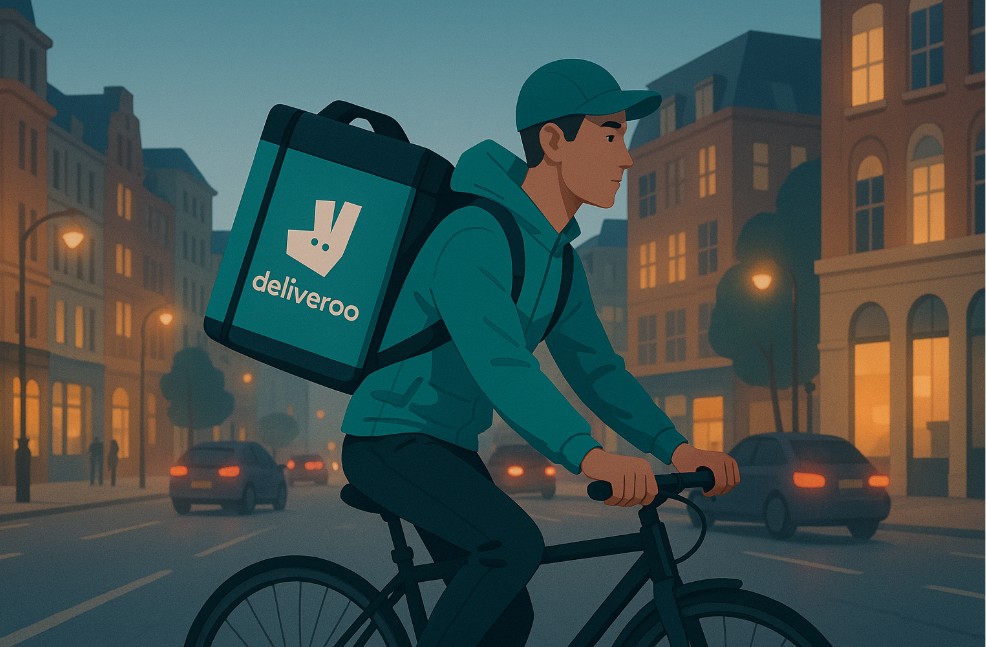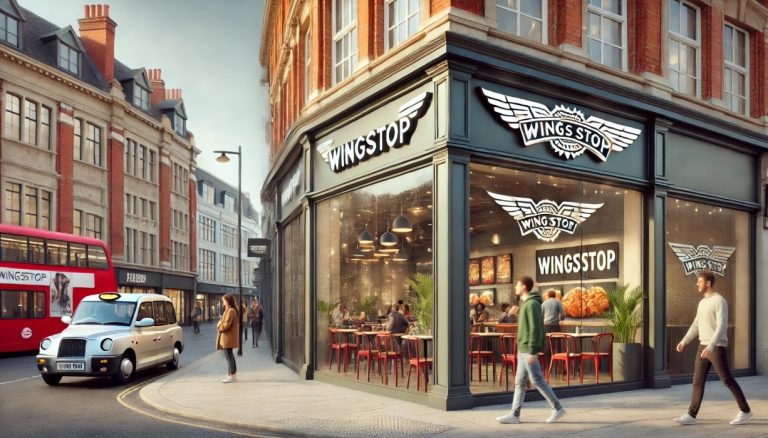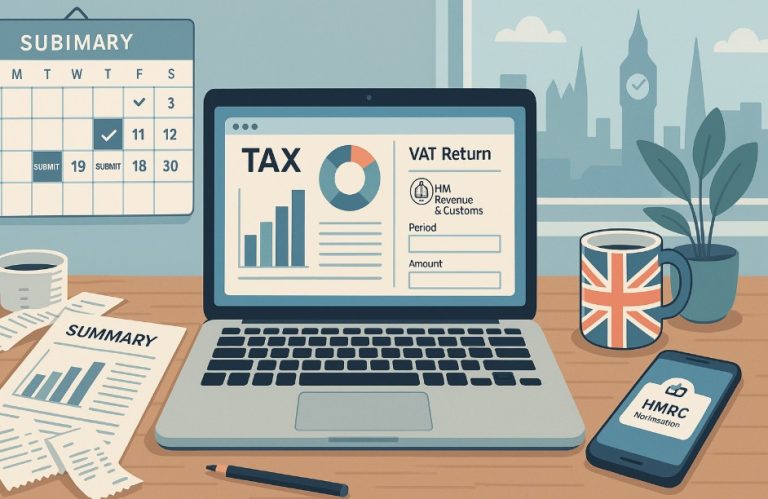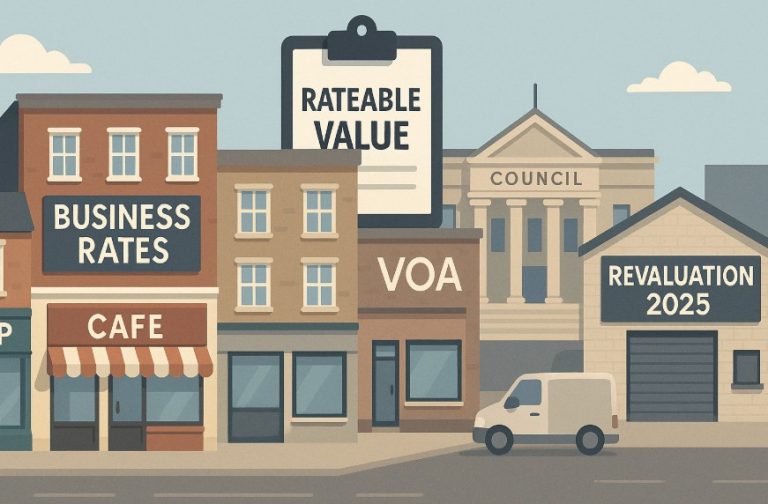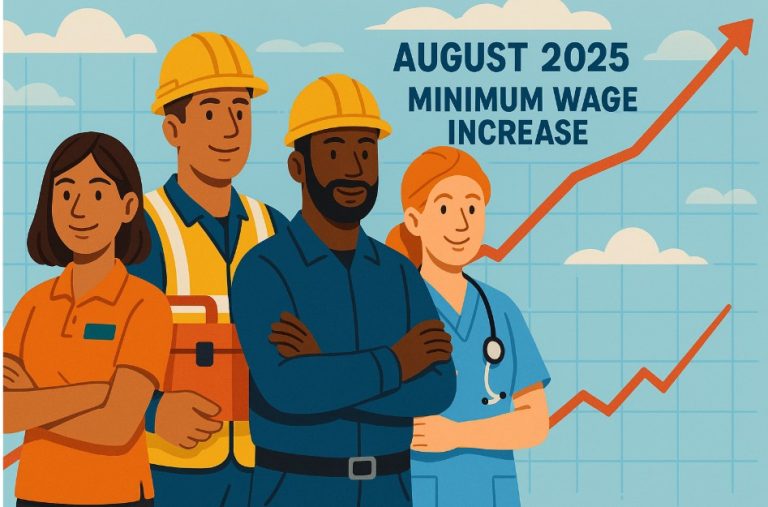How Much Does a Deliveroo Driver Make?
Is working as a Deliveroo driver in the UK in 2025 still a financially viable option? With food delivery apps continuing to dominate urban convenience, many people, students, part-timers, and even career switchers are considering Deliveroo as a flexible income source. But one of the most common and important questions remains: how much can a Deliveroo driver actually make?
This blog will explore in detail what Deliveroo drivers earn in the UK, how their pay is calculated, what influences their income, and how those figures compare to similar roles. Whether you’re evaluating it as a side hustle or full-time option, this guide will help you understand exactly what to expect.
What Is Deliveroo’s Pay Structure and How Are Riders Compensated?

Deliveroo does not pay its drivers an hourly wage by default. Instead, drivers known as “riders”are classified as self-employed and compensated on a per-delivery basis.
This means their earnings depend directly on how many orders they complete, how far they travel, and the time of day.
The standard delivery fee typically includes a base rate that can range from £2.90 to £4.50 per delivery. In addition to this base, riders may earn more for travelling longer distances or delivering during busy periods, such as lunch and dinner time.
These periods often come with temporary pay boosts, known as “peak pay” or “boost fees”, which Deliveroo uses to incentivise drivers to be available when demand is high.
Deliveroo riders are paid weekly by direct deposit. However, they can choose to cash out their earnings instantly via the app for a small processing fee. Riders keep 100% of the tips they receive, which can be added by customers either through the app or in cash.
How Much Do Deliveroo Drivers Earn Per Hour in the UK?
There is no universal figure that applies to every Deliveroo driver, but most riders report earnings within a certain range.
Based on recent job review platforms, rider feedback, and salary aggregator data, the average reported hourly earnings range between £8 and £14, although some experienced riders claim they earn up to £20 per hour during peak times in high-demand areas.
An often-cited figure is £14.99 per hour, which appears to be a commonly reported average by full-time riders working during peak times in central cities like London, Manchester, or Birmingham.
However, this number can be misleading if taken out of context. It typically includes tips and occasional bonuses and assumes a strategic working schedule that prioritises high-demand periods.
Estimated Earnings by Hour Type
| Time Frame | Estimated Hourly Earnings |
| Off-Peak (Mid-morning, early afternoon) | £8 – £10 |
| Standard (Mid-week evenings) | £10 – £12 |
| Peak (Lunch/Dinner, Weekends) | £12 – £20 |
It’s important to note that these figures are gross earnings before any expenses or deductions.
What Factors Influence a Deliveroo Driver’s Pay?
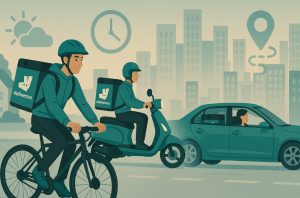
Several variables significantly affect how much a rider earns on any given day. One of the most impactful factors is the time of day.
Riders who work during peak hours typically between 12:00 pm to 2:00 pm and 6:00 pm to 9:00 pm generally earn more because of both increased order volume and the application of peak pay.
Another major influence is the location where a rider operates. Busier cities such as London, Manchester, and Birmingham tend to have a higher concentration of restaurants and a greater density of customers, leading to shorter delivery times and more jobs per hour.
In contrast, riders working in smaller towns or rural areas may face longer travel distances and fewer orders.
The type of vehicle a rider uses also plays a role. While cyclists benefit from minimal running costs, they may complete fewer deliveries compared to those using scooters or cars.
Motorised vehicles, although more efficient, come with costs like fuel and insurance, which must be considered when calculating take-home pay.
Other contributing factors include weather, local promotions, rider experience, and customer tipping behaviour. The more efficient and strategic a rider is, the higher their earnings potential.
How Do Tips and Bonuses Affect Deliveroo Rider Income?
Tips are an essential and often underestimated component of a rider’s income. Deliveroo allows customers to tip directly via the app either at the time of order or after delivery. Riders receive 100% of any tip given, with no deductions taken by the platform.
The average tip per order can range from £0.50 to £2, although in some cases customers may tip more generously, particularly for fast or friendly service.
For riders who complete 3 to 4 deliveries per hour during peak times, even small tips can add up quickly, enhancing hourly earnings by several pounds.
In addition to tips, Deliveroo occasionally offers bonuses or incentives. These might include completing a certain number of deliveries within a fixed time frame or working specific shifts where demand is expected to be high. Riders are notified about these promotions via the app or email and can choose to opt in.
Bonuses and tips are typically paid on the same schedule as delivery fees, although instant payout options exist for tips as well, giving riders more immediate access to their earnings.
What Expenses Do Deliveroo Drivers Need to Cover?
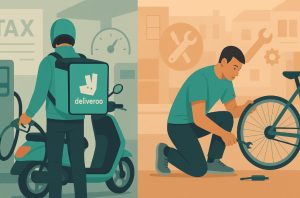
Because Deliveroo riders are self-employed, they must cover all their own job-related expenses. These out-of-pocket costs vary depending on the vehicle used and the amount of time spent on the road.
Common expenses include:
- Fuel (for scooters and cars)
- Tyre replacements and mechanical repairs
- Mobile phone data plans
- Insurance (such as public liability and vehicle insurance)
- Protective equipment (helmets, jackets, lights, etc.)
- Taxes and National Insurance Contributions
While cyclists avoid fuel costs, they still incur expenses for bike maintenance and safety gear. Riders must also be mindful of their tax responsibilities.
As self-employed individuals, they are required to file a tax return and may be liable for income tax and National Insurance, depending on total earnings.
Keeping detailed records of mileage, receipts, and maintenance can help offset some of these costs through allowable expenses when filing taxes with HMRC.
How Does Deliveroo Pay Compare to Other Roles Within the Company?
Although Deliveroo riders represent the brand’s public-facing workforce, there is a wide disparity in pay compared to internal staff and technical roles.
According to salary data submitted by employees on platforms like Glassdoor, here’s a comparison between delivery roles and corporate roles within Deliveroo:
| Role | Hourly Base Pay |
| Delivery Rider | £8 – £12 |
| Senior Delivery Rider (Reported) | £10 – £14 |
| Account Manager | £12 – £18 |
| Software Engineer | £31 – £38 |
| Senior Software Engineer | £42 – £48 |
| Data Scientist | £30 – £36 |
| Senior Data Scientist | £43 – £47 |
While tech and office-based roles clearly offer higher compensation, they require formal qualifications and are full-time salaried positions. Riders, in contrast, enjoy full control over their working hours and routes.
How Do Deliveroo Riders Compare to Other Food Delivery Drivers in the UK?
Deliveroo is just one of several major delivery platforms in the UK, with Uber Eats and Just Eat being the primary competitors. Each platform has different pay models and structures.
| Platform | Hourly Pay (Avg) | Flexibility | Bonus System | Payout Frequency |
| Deliveroo | £9 – £14 | High | Yes | Weekly / Instant |
| Uber Eats | £8 – £13 | High | Yes | Weekly / Instant |
| Just Eat | £10 – £12 | Medium | Occasionally | Weekly |
Deliveroo tends to be favoured by those seeking maximum flexibility, as there is no fixed schedule and riders can log in and out of the app at will.
Uber Eats offers similar autonomy, while Just Eat often employs drivers directly on hourly contracts, which reduces flexibility but offers more predictable pay.
What Are Some Tips to Maximise Deliveroo Rider Earnings?

Success as a Deliveroo driver depends heavily on working smart. Riders who earn the most are often those who understand when and where to work, manage their costs, and maintain a strong customer service approach.
Some effective strategies include:
- Focusing on high-demand zones, such as city centres and busy restaurant hubs
- Working during peak hours, especially lunch and dinner times on weekends
- Using multiple platforms to reduce downtime between orders
- Staying informed about promotions and peak pay through the Deliveroo rider app
- Delivering with speed and professionalism to encourage tips
While it’s not always possible to predict the busiest times, paying attention to patterns and customer habits can significantly boost income.
Is Being a Deliveroo Driver Still Worth It in 2025?

For many people, Deliveroo offers an attractive way to earn flexible income. The role is particularly suited to students, part-timers, or those who value freedom over structure.
With potential earnings ranging between £8 and £20 per hour, and the ability to work independently, Deliveroo can be a lucrative opportunity if approached strategically.
However, the lack of job security, no holiday pay, and out-of-pocket expenses may be drawbacks for those looking for stable or long-term employment.
Riders must also manage their own taxes, plan for slower periods, and invest in their own equipment and vehicle upkeep.
Ultimately, whether Deliveroo is “worth it” depends on individual goals and expectations. Those who prioritise flexibility, enjoy the autonomy of freelance work, and can manage their expenses well may find it a rewarding gig.
What Is the Pay Breakdown for Deliveroo Riders Across UK Cities?
To offer more context, here’s a comparative look at estimated earnings in major UK cities.
| City | Average Hourly Pay | Peak Bonuses | Monthly Take-Home (Est.) |
| London | £10.50 – £14.00 | Up to £3 | £1,500 – £2,000 |
| Manchester | £9.00 – £12.00 | Up to £2.50 | £1,200 – £1,800 |
| Birmingham | £8.50 – £11.50 | Up to £2 | £1,000 – £1,600 |
| Glasgow | £8.00 – £10.50 | Up to £1.50 | £900 – £1,400 |
These figures represent gross earnings and do not account for expenses or taxes. However, they offer a useful benchmark for evaluating earning potential in different regions.
Conclusion: What Can Deliveroo Drivers Realistically Earn?
Deliveroo drivers in the UK can earn between £8 and £20 per hour, depending on factors like time of day, location, delivery volume, and individual efficiency.
On average, full-time drivers can make up to £2,000 per month, although this figure drops once expenses are deducted.
While the income may not match salaried employment in other sectors, the appeal lies in flexibility, autonomy, and quick access to earnings.
For those who plan their work wisely and understand the nuances of the platform, Deliveroo continues to be a viable and popular gig economy option in 2025.
Frequently Asked Questions
How are Deliveroo drivers paid?
Deliveroo pays drivers per delivery, with additional bonuses and 100% of tips. Payment is made weekly, with instant cash-out available.
What affects Deliveroo earnings the most?
Key factors include time of day, location, demand, type of vehicle used, and customer tipping habits.
Do Deliveroo riders need insurance?
Yes, riders must arrange their own public liability and, if using a motor vehicle, relevant insurance policies.
Can students earn well with Deliveroo?
Many students report earning between £400 and £800 per month by working part-time around their studies.
Are Deliveroo riders employees?
No, they are self-employed and responsible for managing taxes, expenses, and insurance.
Can I work for Deliveroo and Uber Eats at the same time?
Yes, many riders use multiple platforms to increase order volume and earnings.
Is Deliveroo pay consistent across the UK?
No, pay varies significantly based on city, order volume, and local customer habits.

